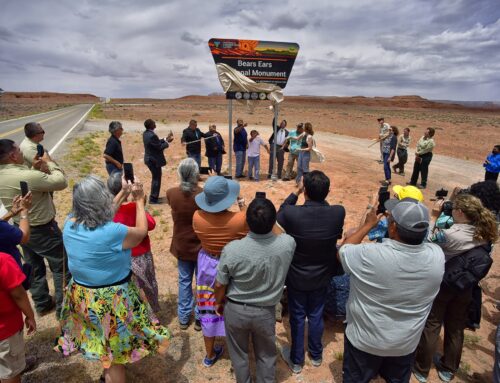Executive Summary
The five Tribes of the Bears Ears Inter-Tribal Coalition (BEITC) – Hopi, Navajo (Diné), Ute Indian Tribe, Ute Mountain Ute, and Pueblo of Zuni — have deep traditional cultural beliefs that tie them to the land. The physical world is much more than just a natural realm to sustain the material needs of life. The origin of the canyons, cliffs, and landforms of the greater Bear’s Ears region have a place in traditional history. There are narratives that provide a continuity that link people, landscapes, and supernatural beings through time.
The purpose of the BEITC Land Management Plan is intended to provide a synthesis of Tribal perspectives on managing the landscape of the Bears Ears National Monument (BENM). The BEITC Land Management Plan emphasizes a holistic approach to all resources that gives primacy to indigenous knowledge and perspectives on the stewardship of the Bear’s Ears landscape. Although prepared for BENM, this plan can also be applied beyond the boundaries of the Monument, as it is intended to provide the foundation for proactive collaborative management of ancestral lands that extend well beyond current reservation boundaries.
The Bear’s Ears region has significance that is greater than any single Native group. It is a sacred landscape that transcends individual Tribal concerns. The goals of having collaborative management in BENM can be summarized as follows:
• Establish a proactive process for the Tribal Nations of the BEITC to collaboratively manage BENM with Federal land managers.
• Have indigenous knowledge and Native ways of knowing given equal consideration with knowledge from processes framed by a Western scientific paradigm.
• Create by-laws for equity between Tribes and Federal land managers that will also ensure continuity of collaborative management.
• Create a full-time Tribal Management staff to participate in collaborative management with Federal land managers.
• Secure Federal funding for full-time Tribal Management Staff.
• Establish and fund a Traditional Knowledge Institute that has programs that would have a Native benefit.
• Establish a reciprocal relationship between Tribes and Federal land managers regarding sharing of indigenous knowledge with information collected within a Western scientific paradigm.
• Enhanced data sharing and acquisition for Tribes.
• Tribal input regarding adapting the collaborative land management plan over time.
Collaboration between Tribal Nations and Federal land managers is proposed as the foundation of true co-management of these important lands. Collaboration includes on-going, meaningful Native engagement but is not intended to supplant or replace Section 106 consultation. Instead, the BEITC proposes to increase the involvement of Tribes early and often so as to be proactive in the land management planning process instead of perpetuating the reactive relationship between Tribes and land management agencies. Collaboration between Tribal Nations and Federal agencies is seen as the foundation for both planning and implementation of day-to-day management decisions with the common goal of long-term, sustainable management of the Bears Ears landscape.
The plan presented here summarizes the main points of the BEITC position on how they view and interact with this landscape and how the approach to land management at Bears Ears should be different. It is understood that this is not to be the final document for the management of BENM but is instead the beginning of implementing a new chapter in collaboration and co-management of ancestral lands. This plan is intended to be a living document that will be added to and evolve as different needs on the landscape arise.
Download the entire PDF.
Download the Bears Ears – Land Management Plan Appendix.



